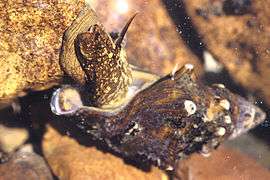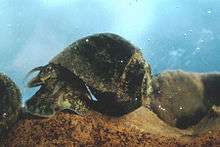Pleuroceridae
Pleuroceridae, common name pleurocerids, is a family of small to medium-sized freshwater snails, aquatic gilled gastropod mollusks in the superfamily Cerithioidea.These snails have an operculum and typically a robust high-spired shell.
| Pleuroceridae | |
|---|---|
 | |
| Io fluvialis | |
 | |
| Athearnia anthonyi | |
| Scientific classification | |
| Kingdom: | |
| Phylum: | |
| Class: | |
| (unranked): | |
| Superfamily: | |
| Family: | Pleuroceridae Fischer, 1885 |
| Diversity[1][2] | |
| About 150 extant species | |
Reproduction is iteroparous, and juvenile snails emerge from eggs laid on a firm surface by a gonochoristic female. There is no veliger stage.
Distribution
As currently defined, this family is confined entirely to eastern North American fresh waters. Similar snails formerly classified with Pleuroceridae, but now assigned to other families are widespread in temperate and tropical parts of Southern and Eastern Asia, and Africa. Most require unpolluted rivers and streams, but a few are adapted to living in lakes or reservoirs.
Taxonomy
2005 taxonomy
The following two subfamilies have been recognized in the taxonomy of Bouchet & Rocroi (2005):[3]
- Pleurocerinae P. Fischer, 1885 - synonyms: Ceriphasiinae Gill, 1863; Strepomatidae Haldeman, 1864; Ellipstomatidae Hannibal, 1912; Gyrotominae Hannibal, 1912; Anaplocamidae Dall, 1921
- Semisulcospirinae Morrison, 1952 - synonym: Jugidae Starobogatov, Prozorova, Bogatov & Sayenko, 2004 (n.a.)
2009 taxonomy
Subfamily Semisulcospirinae within Pleuroceridae was elevated to family level Semisulcospiridae by Strong & Köhler (2009).[4]
Genera
There is very high level of mitochondrial heterogeneity in apparent species of Pleuroceridae (highest among gastropods, also with Semisulcospiridae), that has not been sufficiently explained yet as of 2015.[5]
Genera within the family Pleuroceridae are organized in the one subfamily only since 2009 and they include:
Pleurocerinae
- Pleurocera Rafinesque, 1818 - type genus of the family Pleuroceridae,[3]
- Elimia H. Adams & A. Adams, 1854 synonyms:Goniobasis Lea, 1862
- Athearnia Morrison, 1971
- † Gyrotoma Shuttleworth, 1845
- Io Lea, 1831 - with the only species Io fluvialis (Say, 1825)
- Leptoxis Rafinesque, 1819
- Lithasia Haldeman, 1840
References
- Strong E. E., Gargominy O., Ponder W. F. & Bouchet P. (2008). "Global Diversity of Gastropods (Gastropoda; Mollusca) in Freshwater". Hydrobiologia 595: 149-166. hdl:10088/7390 doi:10.1007/s10750-007-9012-6.
- Strong E. E., Colgan D. J., Healy J. M., Lydeard C., Ponder W. F. & Glaubrecht M. (2011). "Phylogeny of the gastropod superfamily Cerithioidea using morphology and molecules". Zoological Journal of the Linnean Society 162(1): 43-89. doi:10.1111/j.1096-3642.2010.00670.x.
- Bouchet, Philippe; Rocroi, Jean-Pierre; Frýda, Jiri; Hausdorf, Bernard; Ponder, Winston; Valdés, Ángel & Warén, Anders (2005). "Classification and nomenclator of gastropod families". Malacologia. Hackenheim, Germany: ConchBooks. 47 (1–2): 1–397. ISBN 3-925919-72-4. ISSN 0076-2997.
- Strong E. & Köhler F. (2009). "Morphological and molecular analysis of "Melania" jacqueti Dautzenberg & Fischer, 1906: from anonymous orphan to critical basal offshoot of the Semisulcospiridae (Gastropoda: Cerithioidea)". Zoologica Scripta 38(5): 483-502. doi:10.1111/j.1463-6409.2008.00385.x
- Whelan N. V. & Strong E. E. (2015). "Morphology, molecules and taxonomy: extreme incongruence in pleurocerids (Gastropoda, Cerithioidea, Pleuroceridae)". Zoologica Scripta> 26 pp. doi:10.1111/zsc.12139.
Further reading
- Tryon G. W. (1865). "Observations on the family Strepomatidae". American Journal of Conchology 1(2): 97-135.
- Tryon G. W. (1865). Synonymy of the species of Strepomatidae (melanians) of the United States; with critical observations on their affinities, and descriptions of land, fresh water and marine Mollusca. New York, Ballière Brothers, 520 Broadway, 100 pp., 2 plates.
- Graf, D. L. (2001). The cleansing of the Augean Stables, or a lexicon of the nominal species of the Pleuroceridae (Gastropoda: Prosobranchia) of recent North America, North Mexico. Walkerana. 12(27): 1-124